#Pandro S. Berman
Text

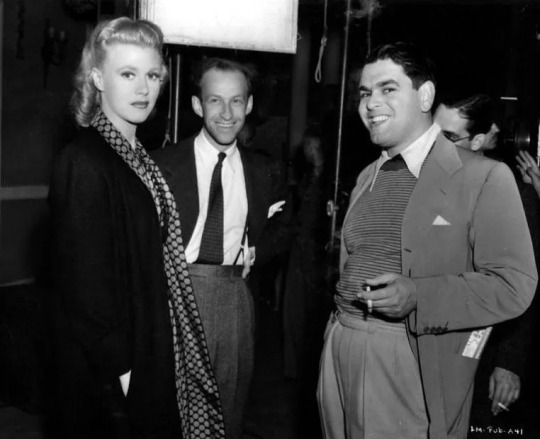


Producer Pandro S. Berman was #botd in 1905
18 notes
·
View notes
Text
Love Crazy (1941)
Love Crazy by #JackConway starring #WilliamPowell and #MyrnaLoy, "not as polished as the greatest comedies of remarriage... but don’t sleep on it either"
JACK CONWAY
Bil’s rating (out of 5): BBB.5
USA, 1941. Metro-Goldwyn-Mayer. Story by David Hertz, William Ludwig, Screenplay by William Ludwig, Charles Lederer, David Hertz. Cinematography by Ray June, William H. Daniels. Produced by Pandro S. Berman. Music by David Snell. Production Design by Cedric Gibbons. Costume Design by Eugene Joseff. Film Editing by Ben Lewis.
Myrna Loy and William Powell…
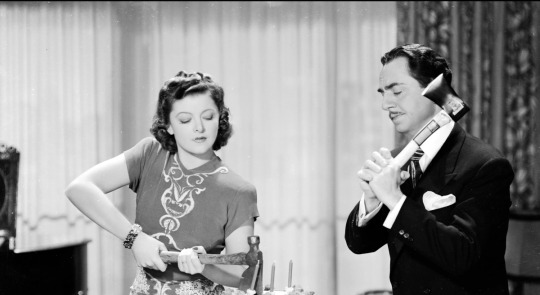
View On WordPress
#Ben Lewis#Cedric Gibbons#Charles Lederer#Clarence Muse#David Hertz#David Snell#Donald MacBride#Elisha Cook Jr.#Eugene Joseff#Fern Emmett#Florence Bates#Gail Patrick#George Meeker#Jack Carson#Jack Conway#Joseph Crehan#Kathleen Lockhart#Metro-Goldwyn-Mayer#Myrna Loy#Pandro S. Berman#Ray June#Sara Haden#Sidney Blackmer#Sig Ruman#Vladimir Sokoloff#William H. Daniels#William Ludwig#William Powell
1 note
·
View note
Text
Elvis escaped a crew-length haircut more than once before the army
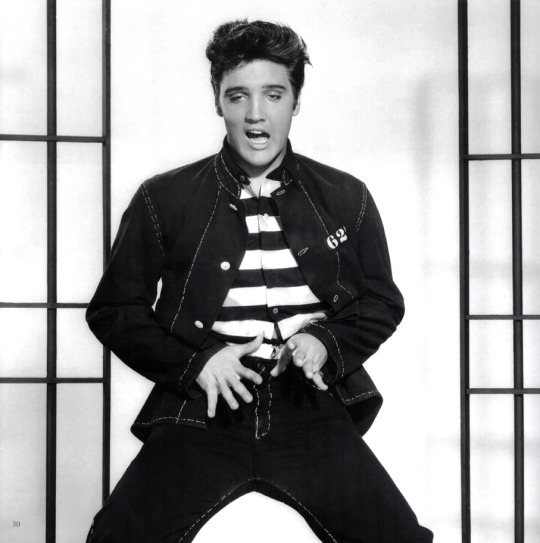
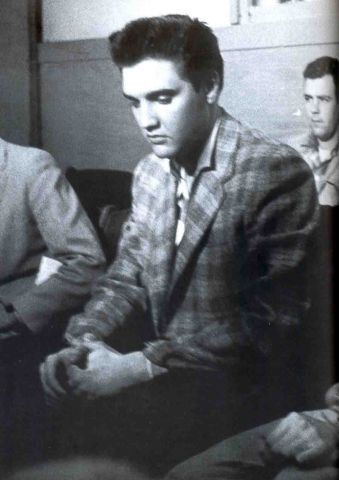


It is widely known by the fans that one funny story of how Red West saved Elvis from getting his hair cut off by bullies when he was only a teenager attending the Humes High School in Memphis, Tennessee. For those who never heard/read this story before, well.. long story short, Elvis was kind of a misfit in High School because of the way he used to dress different from his mates. "He looked like a sore thumb," said Ronny Trout, a classmate who shared a workbench with Elvis in wood shop in school (as wrote by Peter Guralnick in one of his books on Elvis). While all the guys usually had crew cuts and dressed in jeans, Elvis had this "movie star" look. Apart from the flashy clothes — such as ascot ties and dress pants Presley is said to have worn while attending classes — he also would proudly show off his truck driver sideburns and a duck tail hairstyle around the hallways. Some of the kids in his school just couldn't stand it. Most of them thought Elvis looked weird, possibly they got the impression as if he was cocky or something but more likely they just found him strange, out of place. One day some guys corned Elvis in the bathroom and threatened to cut his hair right off. Red West came in just in time. Even tho they weren't friends yet, that selfless good deed of Red turned Elvis into a, let's say, fan of his. Presley was beyond grateful for the unexpected help. This was before Elvis was, you know, "Elvis". West and Presley became friends after this day, little by little - not immediately, and it turns out that a long, long term friendship between the two came out of that uncanny situation. At a point, Red West became part of Elvis' personal security guard and remained friends with him up until July 1976, a little more than one year previous to Elvis's death in August 1977. Anyway, Red's efforts only postponed Elvis' haircut. Presley actually had to surrender to the crew cut style in March 1958 when he was inducted into the U.S. Army. But did you know before the Army's intervention and after the High School incident, there was another time when Presley's hair almost was chopped off? That was during movie production of "Jailhouse Rock", in 1957.
The still photographs of Elvis wearing the short "Butch" wig were taken on Monday, May 13, 1957. William Tuttle (head of the make-up at MGM Studios) and his department produced very convincing results. This was the first time the wig was ready to be fitted, and the first scene shot using the wig was on May 20, scene 11 - Barber Shop. Elvis is wearing the wardrobe for Scenes 5 & 6 - Courtroom.
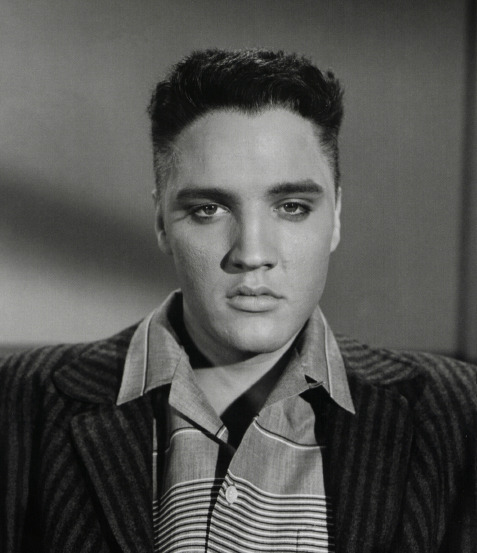
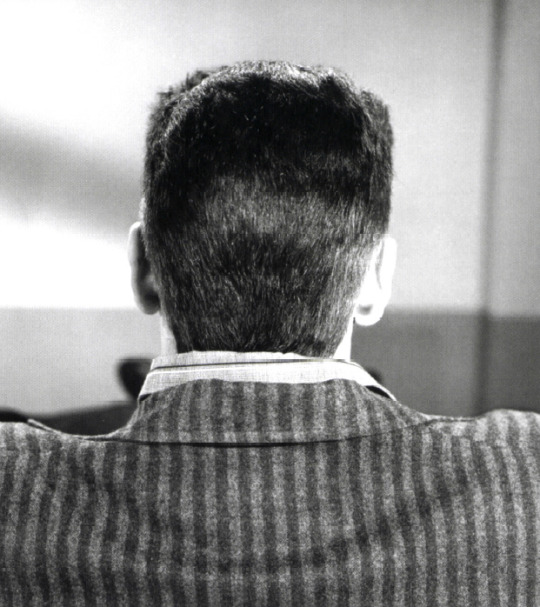

Having read the script for Jailhouse Rock, Elvis was fully aware that the storyline called for his character to be sent to prison, and was told by the studio that, to be authentic, he would have to get his hair clipped.
Elvis set off a personal appearance tour, prior to reporting to MGM Studios in Hollywood. The short tour commenced on March 28, 1957. The first stop was Chicago, at a press conference at the Saddle and Sirloin Club at the Stockyards Inn that afternoon, when Elvis spoke to the assembled press. When the subject of his haircut for his new picture was raised, he revealed: 'When I get back to Hollywood, I'm gonna have my hair cut. They're gonna cut it down to crew length for this new movie. Personally, I don't care if they cut my hair, I don't think it makes much difference. Because it'll grow out again.'

March 28, 1957. Elvis Presley at a press conference at the Saddle and Sirloin Club at the Stockyards Inn, Chicago, Illinois.
Within a week, MGM Studios and producer, Pandro S. Berman, were swamped with four thousand letter and post-cards from Presley fans begging that the studio let their hero act with his original hair. "Don't Be Cruel - Don't Cut Elvis' hair," they demanded in varying terms. Some threatened to boycott the picture; some said they'd see it anyway because they'd always be loyal to Elvis - but they'd be "All Shook Up."
It was decided something had to be done to save Elvis' hair and also alleviate the fans' feelings, so the Studio started to look at alternative ideas with tests quickly set up in the Studio make-up department under the stewardship of William Turtle, head of the make-up at MGM Studios. Elvis revealed the solution to columnist Aline Mosby, 'So now the studio has decided I'll wear a wig, a crew-cut wig, for the prison scenes.'
During pre-production, tests were undertakes with the 35mm film camera, to establish any issue. It was realized by Director of Cinematography, Robert J. Bronner, that Elvis' hair required a red tint due to the black and white film. Elvis later confirmed this in an interview once filming had been completed: 'My hair will look the same, except it was reddened because in black-and-white it photographed like a cap instead of hair.'
The fans plea worked good this time but there's the old saying that goes like: "what's meant to be will be".
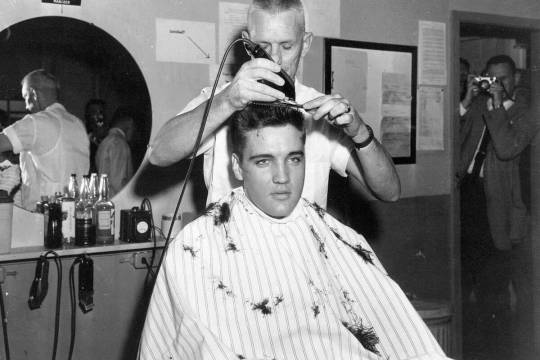
Elvis Presley gets his hair cut before entering the Army, at Fort Chaffee in Barling, Arkansas. Presley entered the service March 24, 1958 at Fort Chaffee Reception Station. Picture of the 23-year-old rock star and barber Pete Peterson.
On December 10, 1957 Elvis received a letter from the Memphis Draft Board notifying him he was up for the next military draft. Presley's fans, once more, confident that their pleas would be heard just as they were by the Hollywood people, begun sending hundreds of letters to certainly everyone they could find would be helpful on the matter. They begged, "Please, please, do not touch Elvis' hair!" — some of them even felt kinda "suicidal" about Elvis' hair being cut off. One of the fan letters addressed to then U.S. President, read: "Dear President Eisenhower, My girlfriends and I are writing all the way from Montana. We think it's bad enough to send Elvis Presley to the army, but if you cut his sideburns of, we will just die."
NO DEAL WAS MADE THIS TIME. On March 24, 1958 Elvis was inducted into the U.S. Army and finally had to surrender to the crew-haircut. Truth be told, his fresh unfamiliar haircut didn't affect a bit his exquisite beauty - if anything, Presley appealed even worse to his female audience as a soldier.
Well, that's it. There it goes the story of how it took at least three attempts, including one movie and the U.S. government, to finally get that famous sideburns and pompadour out of Elvis' pretty little head.

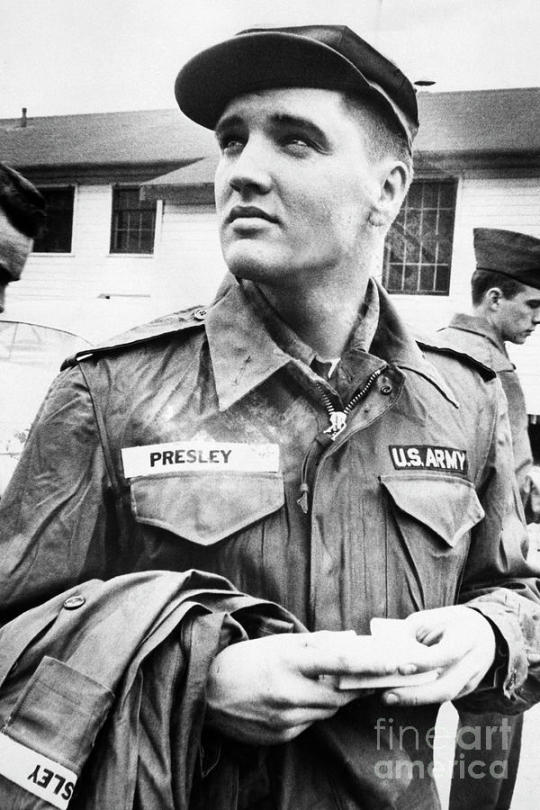
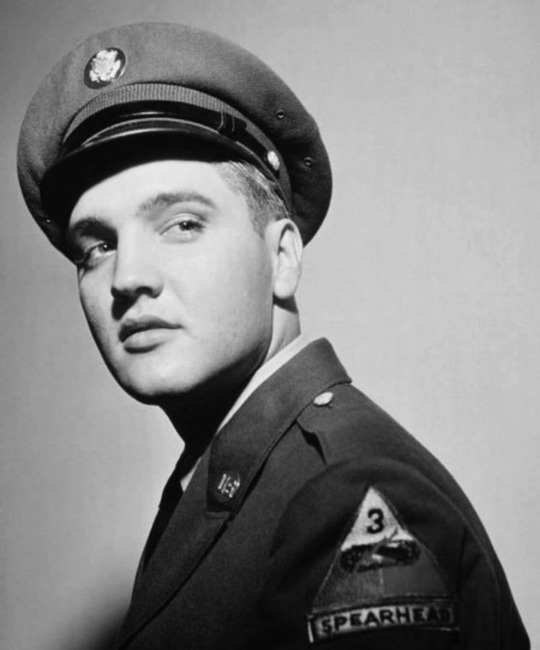
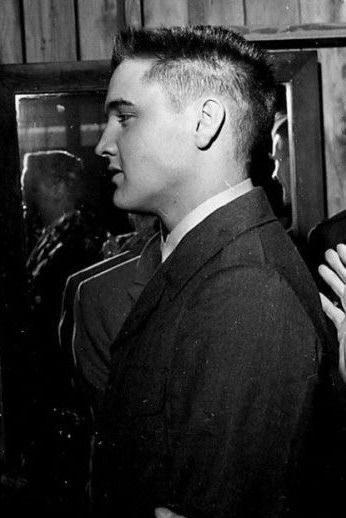
SOURCE: Excerpts from book "The Making Of Jailhouse Rock" (Book "Movie") by David English and Pål Granlund (2021).
#50s elvis#elvis presley#jailhouse rock#1957#U.S. army#army elvis#1958#elvis#military#elvis the king#elvis fans#elvis fandom#elvis history#us army#rock and roll history#elvis' haircut
26 notes
·
View notes
Text
Knights of the Round Table 1953










First MGM film to be shot in CinemaScope.
Robert Taylor was never comfortable filming these types of movies. He often referred to them as "iron jockstrap" movies and actually preferred doing westerns.
Knights of the Round Table was the second in an unofficial trilogy. The other two movies were Ivanhoe and The Adventures of Quentin Durward. The three movies were made by producer Pandro S. Berman and director Richard Thorpe. Robert Taylor starred in all three movies.
13 notes
·
View notes
Text
The Best Picture Oscar My Way (1951-1979)
Here is Part 3 of my “Best Picture My Way” series. The last two are found here. My stipulations can be found in Part 1.
For convenience sake, I’ll relay this message. For Best Picture, I’m only gonna list the nominated producer for newly added films (here’s the Wikipedia page for the rest). I will mostly go with the ones credited as “produced by” or “p.g.a.” (if the latter is shown) on IMDB as the nominees. Limit is five.
Also, if you’re wondering why there are more years listed here than the other two, that’ll be answered in the next part.
1951
Rashomon - Minoru Jingo
Ace in the Hole - Billy Wilder
A Place in the Sun
Strangers on a Train - Alfred Hitchcock
A Street Called Desire
1952
High Noon
Forbidden Games - Robert Dorfmann
Singing in the Rain - Arthur Freed
Moulin Rogue
The Quiet Man
1953
Roman Holiday
From Here to Eternity
Shane
The Big Heat - Robert Arthur
The Stalag 17 - Billy Wilder
1954
On the Waterfront (still)
Rear Window - Alfred Hitchcock
The Caine Mutiny
Dial M for Murder - Alfred Hitchcock
Johnny Guitar - Nicholas Ray
1955
Marty (still)
The Night of the Hunter - Paul Gregory
Rebel Without a Cause - David Weisbart
The Long Grey Line - Robert Arthur
Mister Roberts
1956
Tea and Sympathy - Pandro S. Berman
The Ten Commandments
Giant
The Killing - James B. Harris
The Searchers - Patrick Ford
1957
The Bridge on the River Kwai (still)
12 Angry Men
Nights of Cabiria - Dino De Laurentiis
Witness for the Persecution
The Seventh Seal - Allan Ekelund
1958
Vertigo - Alfred Hitchcock
Mon Oncle - Jacques Tati
Touch of Evil - Albert Zugsmith
Auntie Mame
The Defiant Ones
1959
Ben-Hur (still)
Anatomy of a Murder
North by Northwest - Alfred Hitchcock
Some Like It Hot - Billy Wilder
The Diary of Anne Frank
1960
The Apartment (still)
Psycho - Alfred Hitchcock
Elmer Gantry
The Magnificent Seven - John Sturges
The Alamo
1961
West Side Story (still)
Through a Glass Darkly - Allan Ekelund
The Hustler
Judgment at Nuremberg
Breakfast at Tiffany’s - Martin; Jurow; Richard Shepherd
1962
Lawrence of Arabia (still)
To Kill a Mockingbird
Mutiny on the Bounty
The Man Who Shot Liberty Valance - Willis Goldbeck
The Longest Day
1963
8 1/2 - Angelo Rizzoli
The Great Escape - John Sturges
Lillies of the Field
America, America
Cleopatra
1964
Mary Poppins
Dr. Strangelove
My Fair Lady
The Umbrellas of Cherbourg - Mag Bodard
Woman in the Dunes - Kiichi Ichikawa; Tadashi Ono
1965
The Sound of Music (still)
Doctor Zhivago
A Patch of Blue - Pandro S. Berman; Guy Green
Darling
Ship of Fools
1966
Who’s Afraid of Virginia Woof?
A Man for All Seasons
The Professionals - Richard Brooks
The Sand Pebbles
A Man and A Woman - Claude Lelouch
1967
Persona - Ingmar Bergman
The Graduate
The Jungle Book - Walt Disney
In The Heat of the Night
Guess Who’s Coming to Dinner
1968
2001: A Space Odyssey - Stanley Kubrick
Oliver!
Funny Girl
The Lion in Winter
Rosemary’s Baby - William Castle
1969
Midnight Cowboy (still)
Butch Cassidy and the Sundance Kid
Z
The Wild Bunch - Phil Feldman
Easy Rider - Peter Fonda
1970
Patton (still)
M*A*S*H
Five Easy Pieces
Love Story
Investigation of a Citizen Above Suspicion - Marina Cicogna; Daniele Senatore
1971
The French Connection (still)
The Last Picture Show
McCabe & Mrs. Miller - Mitchell Brower; David Foster
A Clockwork Orange
Fiddler on the Roof
1972
The Godfather (still)
The Emigrants
Cabaret
The Heartbreak Kid - Edgar J. Scherick
The Discreet Charm of the Bourgeoisie - Serge Silberman
1973
Cries and Whispers
The Sting
The Exorcist
American Graffiti
Paper Moon - Peter Bogdanovich
1974
The Godfather Part II (still)
A Woman Under the Influence - Sam Shaw
Chinatown
The Conversation
Blazing Saddles - Michael Hertzberg
1975 (kept the same)
One Flew Over The Cuckoo’s Nest (still)
Barry Lyndon
Dog Dag Afternoon
Jaws
Nashville
1976
Rocky (still)
Taxi Driver
Network
Mikey and Nicky - Michael Hausman
All the President’s Men
1977
Annie Hall (still)
Star Wars
The Goodbye Girl
Eraserhead - David Lynch
3 Women - Robert Altman
1978
The Deer Hunter (still)
Heaven Can Wait
Midnight Express
Days of Heaven - Bart Schneider; Harold Schneider
Dawn of the Dead - Richard P. Rubinstein
1979
Apocalypse Now
All That Jazz
Manhattan - Charles H. Joffe
Alien - Gordon Carroll; David Giler; Walter Hill
Kramer vs. Kramer
#cinema#movies#film#academy award#oscars#alfred hitchcock#francis ford coppola#ingmar bergman#alternative#david lean#stanley kubrick#mary poppins#the godfather#2001: a space odyssey#billy wilder
3 notes
·
View notes
Photo

Fred Astaire, Ginger Rogers, and Erik Rhodes in The Gay Divorcee (Mark Sandrich, 1934)
Cast: Fred Astaire, Ginger Rogers, Alice Brady, Edward Everett Horton, Erik Rhodes, Eric Blore, Lillian Miles, Charles Coleman, William Austin, Betty Grable. Screenplay: George Marion Jr., Dorothy Yost, Edward Kaufman, based on a musical play by Dwight Taylor. Cinematography: David Abel. Art direction: Carroll Clark, Van Nest Polglase. Film editing: William Hamilton. Music: Max Steiner (score), Mack Gordon and Harry Revel, Con Conrad and Herb Magidson, Cole Porter (songs).
Obviously, The Gay Divorcee wouldn't pass muster as the title for a heterosexual romantic comedy today, but the film's producers had to jump a few hurdles even in 1934, when the Hays Office censors were about to yield to the much stricter Production Code. The title of the Broadway musical on which the movie was based was Gay Divorce, and Catholic censors were strictly opposed to the idea that divorce could be anything other than a sin. However, assuming that she'd done her penance, a divorcee could be gay (in the older sense), just as Franz Lehár's old operetta asserted that a widow could be merry. This was the first teaming of Fred Astaire with Ginger Rogers in which they were the stars: They had been supporting players in their previous film, Flying Down to Rio (Thornton Freeland and George Nicholls Jr., 1933), but their dance numbers had caused such a sensation that RKO was eager to craft a musical around them. Pandro S. Berman, head of production at the studio, purchased the rights to Gay Divorce, in which Astaire had been the star on Broadway, and put a team of writers (including an uncredited Robert Benchley) to work revising the musical's book by Dwight Taylor. The Broadway version had a score by Cole Porter, but all but one of his songs were jettisoned for the film. That song was the best, however: "Night and Day," which gave the stars their first great fall-in-love pas de deux. The screenplay takes the farcical premise of the play: Mimi Glossop (Rogers), seeks a divorce from her husband, and since they're in England, where the only justification for divorce is adultery, she, with the help of her Aunt Hortense (Alice Brady) and the lawyer Egbert Fitzgerald (Edward Everett Horton), arranges to be caught in a hotel room with a professional co-respondent, Rodolfo Tonetti (Erik Rhodes, who had played the role on Broadway). Meanwhile, however, she has fallen in love with Guy Holden (Astaire), an American she has just met -- and, of course, met cute. Through a sequence of screwball accidents, she winds up thinking that he's the co-respondent, and is disgusted that he should have such a sordid job. Eventually, everything is sorted out with the help of a hotel waiter (Eric Blore, also from the Broadway cast). In the middle of everything, there's a 20-minute-long production number centered on the film's big song, "The Continental," for which composer Con Conrad and lyricist Herb Magidson won the first Oscar ever given for a song written for a movie. The Gay Divorcee would rank with the best Astaire-Rogers films if it had a better score. Aside from "Night and Day," the rest are mostly forgettable novelty numbers, like "Let's K-nock K-nees," which is performed by a then-unknown Betty Grable with Horton and a gang of chorus members.
4 notes
·
View notes
Text
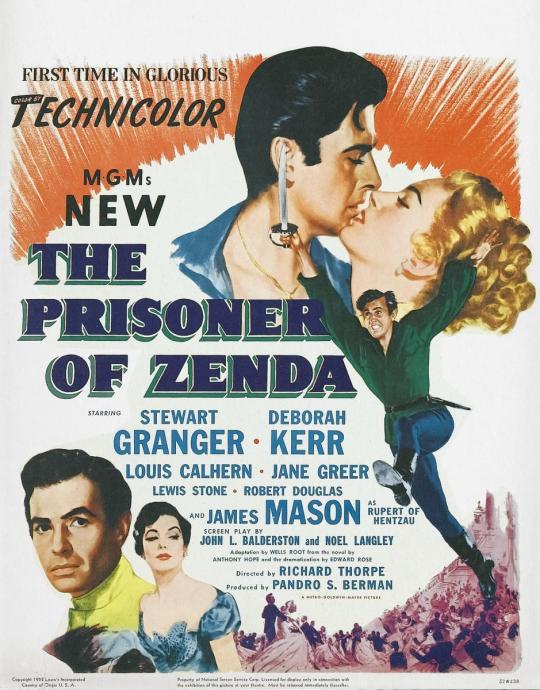
Day 72- Film: The Prisoner of Zenda
Release date: November 4th, 1952.
Studio: MGM
Genre: Adventure
Director: Richard Thorpe
Producer: Pandro S. Berman
Actors: Stewart Granger, Deborah Kerr, James Mason, Louis Calhern, Robert Douglas, Jane Greer
Plot Summary: Rudolf V is about to be crowned King of Ruritania. The night before, however, his evil brother Michael, scheming to be King himself, poisons him with drugged wine. It isn’t enough to kill him, but it makes it impossible for Rudolf to make the coronation. Michael plans to use this to swoop in and grab the throne. As fate would have it, a distant cousin of Rudolf’s, an Englishman named Rassendyll, looks nearly identical to him, and just arrived in the country that day. The King’s aids concoct a plan for Rassendyll to go to the coronation, pretending he is the rightful King. Things get complicated when Rassendyll meets “his” beautiful bride to be.
My Rating (out of five stars): ***
I enjoyed this film in parts, but I also felt like something was missing from it that I can’t quite put my finger on. Something about the way it all comes together as a cohesive whole, maybe? Or is it just lacking that extra spark or oomph? I don’t know, and that made watching it kind of frustrating at times.
The Good:
The sword fighting. There was a nice long sword fighting scene at the end of the movie, and I think that was what I enjoyed the most. The fighting was not at the masterful level of Scaramouche, but it was still highly entertaining.
James Mason. I love James Mason! He can play a smarmy guy like no one else, yet he can also break your heart. In this movie he’s the smarmy evil guy you love to hate. He also proved himself adept at movie swordsmanship.
The costumes. I enjoyed the colorful, beautiful, and fun costumes. The men’s elaborate uniforms were even more eye catching than the women’s stunning dresses.
I liked Granger more in this than in Scaramouche. I think he was a little more charming here because he wasn’t trying so hard to be. He’s definitely a handsome strapping hero type of guy, but I'm still not entirely sold on him for some reason.
The ending. I liked the choice that Debra Kerr’s Flavia made at the end of the film- I found it more interesting than a traditional “happy ever after.”
It was an amusing adventure yarn as a whole. It’s pure lighthearted escapism, but the story itself is engaging.
The Bad:
Sometimes there was confusion between Rupert (Mason) and Michael for me. I wasn’t always sure who wanted what and why. I kind of wish Mason had just played Michael, and that he was more developed as a bad guy.
The fake sets. There were several painted backgrounds and obvious sets that were distracting to me. I know this is kind of a fairytale story, so the background looking storybook-ish doesn’t necessarily have to be a bad thing
None of the characters were very well developed. I didn’t really know much about either Rassendyll, Flavia, or Rudolf V. They were all pretty generic heroes who weren’t very fleshed out.
The accent issue. This one really bugged me. So Rassendyll is impersonating his cousin, but they don’t speak the same language? Or at the least, they must have different accents if they grew up in two completely different countries. It just wasn’t believable that Rassendyll could suddenly speak for Rudolph V and not have his accent be noticed. But I know, I know, it’s just a fantasy story, right?
0 notes
Text


* OUTSTANDING CLASSIC CINEMA #101: "ROBERTA" ©1935 William A. Seiter / Jane Merfin / Sam Mintz et. al. (Musical / Romance / Fashion Genre - Starring: Irene Dunne, Fred Astaire, Ginger Rogers, & Randolph Scott), Produced by Pandro S. Berman / RKP Radio https://www.kellygrant.ca/OutstandingClassicCinema.ubr
1 note
·
View note
Photo


Photoplay, November 1937
#gregory la cava#ginger rogers#katharine hepburn#adolphe menjou#fred astaire#pandro s. berman#stage door#magazine: photoplay#year: 1937#decade: 1930s#type: gossip items and anecdotes#writer: cal york#ph vol. 51 no. 11
4 notes
·
View notes
Photo

Ginger Rogers, director Garson Kanin and producer Pandro S. Berman on the set of Bachelor Mother in 1939
37 notes
·
View notes
Photo


Photos of Ava Gardner During the Filming of ‘Bhowani Junction’
“Bhowani Junction is a 1956 film adaptation of the 1954 novel Bhowani Junction by John Masters made by MGM. The film was directed by George Cukor and produced by Pandro S. Berman from a screenplay by Sonya Levien and Ivan Moffat. “
22 notes
·
View notes
Text




Producer Pandro S. Berman (March 28, 1905 – July 13, 1996)
9 notes
·
View notes
Photo

Today's review on MyOldAddiction.com, Somewhere I'll Find You by #WesleyRuggles starring #ClarkGable and #LanaTurner, "the characters have no chemistry and the constant shift in focus is confusing" WESLEY RUGGLES Bil's rating (out of 5): BB.5. USA, 1942. Metro-Goldwyn-Mayer. Story by…
#Bronislau Kaper#Cedric Gibbons#Charles Dingle#Charles Hoffman#Clark Gable#Frank E. Hull#Harold Rosson#Lana Turner#Lee Patrick#Marguerite Roberts#Metro-Goldwyn-Mayer#Pandro S. Berman#Patricia Dane#Reginald Owen#Robert Kalloch#Robert Sterling#Walter Reisch#Wesley Ruggles
0 notes
Text

The musical documentary, Elvis That's The Way It Is, was shot and released within a few short months from the summer of 1970. Produced at MGM, which was in the process of being dismantled under the harsh regime of James T Aubrey, aka the Smiling Cobra, it had some interesting and highly accomplished people behind it.
It was directed by two-time Academy Award Winner (short subject and documentary), Denis Sanders. The Director of Photography was legendary cinematographer Lucien Ballard who had credits dating back to the 1930s. It was edited by Henry Berman, who also had been working in Hollywood since the '30s and was the brother of producer Pandro S Berman.
The (uncredited) producer was Herbert F Solow, an MGM vice-president in charge of the studio’s US and UK motion picture and television production. Prior to his tenure at MGM, he had worked for Lucille Ball at Desilu and had successfully pitched Star Trek to NBC, along with launching other iconic television franchises.
The movie documented Elvis' summer engagement at the International Hotel, Las Vegas, which was owned by Kirk Kerkorian, who also owned MGM. At that time he was building up his hotel and leisure investments and winding down MGM's film production schedule. In his 2015 obituary, the BBC said that he was well known for buying and selling MGM three times and making a profit each time.
#elvis in the 70s#elvis presley#elvis history#elvis#elvis fans#rock history#elvis 1970s#musicians#las vegas history#las vegas#old hollywood#classic hollywood#golden age of hollywood#classic film
8 notes
·
View notes
Text
ROBERTA
March 8, 1935

Directed by William A. Seiter
Produced by Pandro S. Berman
Screenplay by Jane Murfin, Sam Mintz, and Allan Scott, based on the play Roberta by Jerome Kern and Otto A. Harbach, from the novel Gown’s by Roberta by Alice Duer Miller
Filmed at RKO Studios
World Premiere March 7, 1935 in New York City
Released wide on March 8, 1935

PRINCIPAL CAST
Irene Dunne (Stephanie) was nominated for five Oscars between 1931 and 1949. In 1938 she appeared with Lucille Ball in Joy of Living.
Fred Astaire (Huck Haines) received an honorary Oscar in 1950, and won a competitive Oscar in 1975. He appeared with Lucille Ball in Top Hat (1935), Follow the Fleet (1936) and Ziegfeld Follies (1945).
Ginger Rogers (Countess Scharwenka / Lizzie Gatz) did five films with Lucille Ball. In 1971 she appeared as herself on the “Here's Lucy” episode “Ginger Rogers Comes to Tea” (HL S4;E11), filmed during an actors strike.
Randolph Crane Scott (John Kent) also appeared with Lucile Ball, Astaire and Rogers in Follow The Fleet (1936).
Helen Westley (Roberta, Aunt Minnie) also appeared with Lucille Ball in 1934′s Moulin Rouge.
Victor Varconi (Ladislaw) was a Hungarian-born actor making his only appearance with Lucille Ball.
Claire Dodd (Sophie) was born the same year as Lucille Ball. This is their only film together.
Luis Alberni (Voyda) was a Spanish-born actor making his only appearance with Lucille Ball.
Ferdinand Munier (Lord Delves) did six films with Lucille Ball between 1933 and 1936.
Torben Meyer (Albert) was seen with Lucille Ball in The Farmer and the Dell (1936) and played the German Bandleader in “Lucy in the Swiss Alps” (S5;E21 ~ March 26, 1956).
Adrian Rosley (Professor) is a Romanian-born actor making his only appearance with Lucille Ball.
Bodil Rosing (Fernande) is a Danish-born actress making her only appearance with Lucille Ball.
UNCREDITED CAST

Fashion Models
Lucille Ball makes her 21st film since coming to Hollywood in 1933.
Virginia Carroll
Diane Cook
Lynne Carver
Lorraine DeSart
Betty Dumbries
Maxine Jennings
Myrna Low
Margaret McChrystal
Marie Osborne
Wanda Perry
Donna Mae Roberts
Kay Sutton
Wabash Indianians
Hal Borne
Halbert Brown
Candy Candido
William Carey
Phil Cuthbert
Delmond Davis
Ivan Dow
William R. Dunn
Howard Lally
Muzzy Marcellino
Phil McLarind
Charles Sharpe
Gene Sheldon
Cossacks
Mike Tellegen
Sam Savitsky
Dale Van Sickel
Others
Anna De Linsky
Judith Vosselli
Chris Marie Meeker
Charlotte Russell
Zena Savina
Mike Lally (Bar Patron)
Michael Visaroff (Waiter)
William B. Davidson (Purser)
Mary Forbes (Mrs. Teal)
Rita Gould
Grace Hayle (Miss Jones, Reporter)
Jane Hamilton
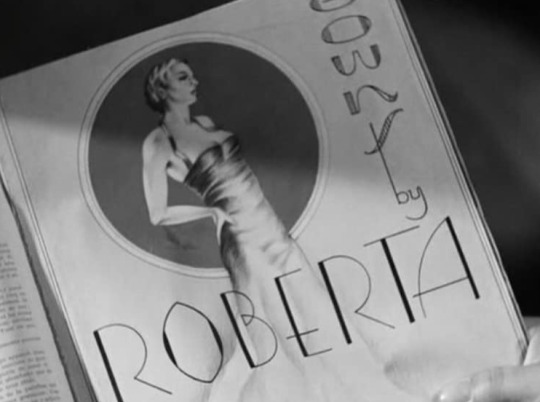
Synopsis ~ Football player John Kent tags along as Huck Haines and the Wabash Indianians travel to an engagement in Paris, only to lose the gig immediately. John and company visit his aunt, owner of a posh fashion house run by her assistant, Stephanie. There they meet the singer Scharwenka (alias Huck's old friend Lizzie), who gets the band a job. Meanwhile, Madame Roberta passes away and leaves the business to John and he goes into partnership with Stephanie.
TRIVIA

Lucille Ball, who appears uncredited in this film as a fashion model, would later buy RKO, the studio that made this film. At the height of their success during “I Love Lucy”, she and Desi Arnaz purchased it and renamed it Desilu Studios.

Lucille Ball decided to try out for this film when she heard RKO was looking for girls who had worked as models at Bergdorf Goodman in New York City. She had not actually been employed by Bergdorf, but had participated in a fashion show a promoter had put on there, so she applied and got the job.
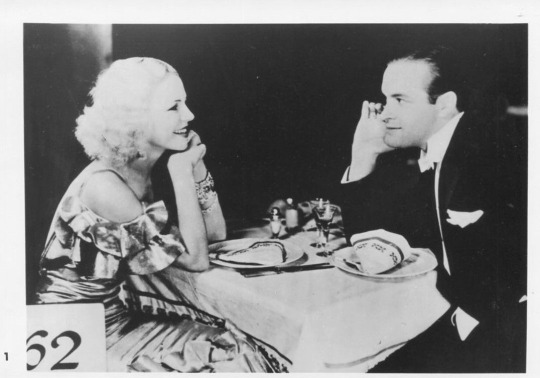
The original 1933 Broadway production of Roberta featured Bob Hope and Fred MacMurray, both of whom played themselves on Lucille Ball sitcoms. Chorus member Leon Alton was a background artist on many episodes of “The Lucy Show” and “Here’s Lucy.”

A 24 year-old Lucille Ball, decked out in white-blonde hair, white furs and wearing a white gown, appears at 1:37:30 in the fashion show sequence. Lucille Ball originally had dialogue that was later deleted.

In the 1971 “Here's Lucy” episode “Ginger Rogers Comes to Tea” (HL S4;E11) Lucy adds a sugar cube to Ginger's tea for the title of each of her favorite films. When Lucy realizes she’s put six lumps of sugar in Ginger’s tea, Rogers says she only wanted Top Hat and Roberta (two lumps).

Clips of the film were included in “Hollywood the Golden Years: The RKO Story: A Woman's Lot” (July 17, 1987). Lucille Ball is also interviewed in the episode.

Fashion Shows were the subject of several Lucille Ball sitcoms: Lucy Ricardo models a Don Loper original; Lucy Carmichael did an impromptu fashion show in a restaurant to get close to Danny Kaye; Lucy Carter did the same thing to help out her daughter Kim, who got her first job at a fashion boutique.

Roberta earned Lucille Ball a promotion at RKO: from clothes horse to actress! Little did Maxine Jennings (red head) know Lucille Ball would eventually steel her thunder as a carrot top!

Some theatre managers took the bold step of offering patrons a money-back guarantee!
5 notes
·
View notes
Photo

“Clark Gable”...the star of Metro-Goldwyn-Mayer’s “Honky Tonk,” hears his call for shooting on the set of the romantic western, in which Gable and Lana Turner are teamed for the first time. Stan Campbell, Gable’s hairdresser remains in the star’s dressing room. Jack Conway directed and Pandro S. Berman produced the Western, which includes in its cast Frank Morgan, Claire Trevor, Albert Dekker, Marjorie Main and Chill Wills.”
27 notes
·
View notes